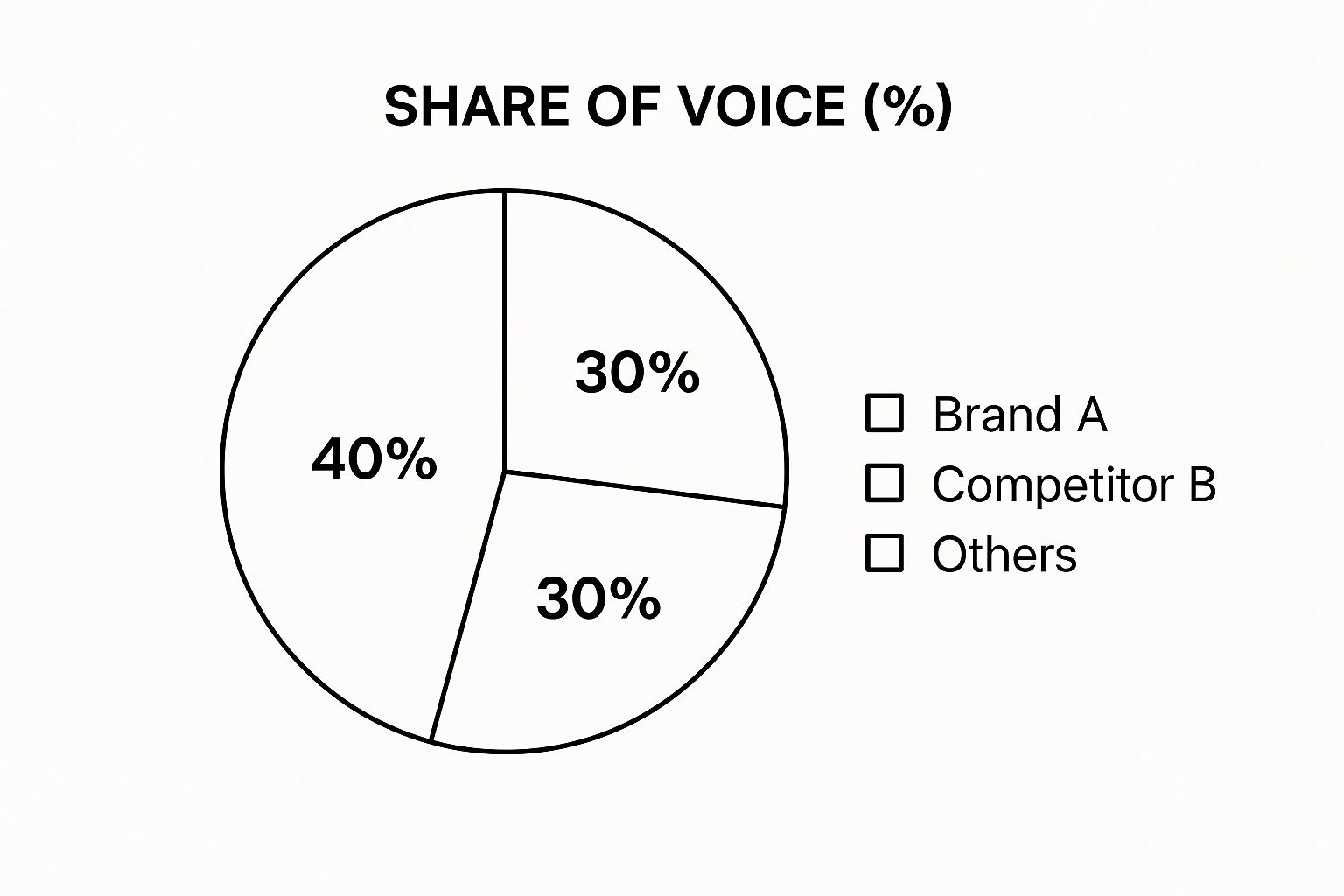
How To Measure PR Effectiveness: Battle-Tested Strategies
The New Reality Of PR Measurement In 2025
The PR world is changing. We've moved beyond simply counting press clippings. Today, it's about understanding the real impact of PR on your business goals. This means we need a smarter, more effective way to measure PR's success.
Understanding The Measurement Maze
Many UK PR agencies are struggling to keep up with today's measurement tools. The sheer amount of data from digital platforms can be overwhelming. Plus, the rise of generative AI creates even more content to track. This means PR pros need to be more selective, focusing on valuable insights instead of just data dumps.
The UK's dynamic media scene makes this even more challenging. In fact, about two in five PR teams have reportedly canceled PR measurement tools due to budget constraints. This shows the pressure on PR pros to prove their worth in a constantly evolving field. Learn more about these PR measurement challenges: Proving Value in 2025: Getting Measurement Right
Focusing On What Matters: Outcome-Based Measurement
Smart brands are now using outcome-based measurement. This means tracking metrics tied to business goals, like leads, brand awareness, and reputation. Instead of just counting mentions, they look at how media coverage drives website traffic, sales leads, and ultimately, revenue. This approach provides clear insights for better decision-making.
Connecting The Dots: Measuring Across Multiple Touchpoints
Today's PR measurement needs to cover everything: social media, website traffic, influencer campaigns, and even offline events. Analyzing data from all these sources gives PR teams a complete picture of their campaign performance, showing which channels are most effective. This helps prove the real value of PR to everyone involved. This broad perspective is essential for understanding how all PR activities contribute to the bigger picture of business success.
Metrics That Actually Move The Needle For Your Business

Stop letting vanity metrics steal your focus. While impressive on reports, they often lack the power to drive tangible business growth. Instead, prioritize metrics that reveal genuine impact. This requires a strategic shift from outdated PR measurement methods. Consider, for example, the move away from Advertising Value Equivalent (AVE).
Traditional metrics like AVE have seen extensive use in UK PR campaigns, but their reliability is now under scrutiny. AVE figures can fluctuate drastically across publications and fail to accurately capture the true influence of PR activities on business goals. In contrast, newer metrics are gaining traction, such as Share of Voice (SoV), media impressions, and brand mentions. For a deeper dive into effective PR measurement, explore these resources: 11 Simple Ways to Measure the Results of Your PR Efforts
Aligning Metrics With Business Goals
The cornerstone of effective PR measurement is aligning your chosen metrics with your specific business objectives. This means understanding which metrics offer the most actionable insights. Whether your focus is boosting brand awareness, generating leads, or managing your reputation, selecting the right metrics is paramount.
If your goal is heightened brand awareness, tracking SoV and reach becomes essential. However, if lead generation is your primary aim, then metrics like website traffic and conversion rates take center stage. This targeted approach empowers you to monitor progress and showcase the value of your PR efforts.
Don't forget the importance of sentiment analysis to gauge public perception. This adds a crucial layer of understanding to your PR campaign’s overall effectiveness, providing a more holistic view of your impact. Further explore the evolving landscape of PR with this insightful resource: How to Master Social Media in PR
Building a Measurement Strategy That Informs Decision-Making
A robust measurement strategy is indispensable for informed decision-making. By prioritizing outcome-based metrics, you can draw a direct line between your PR activities and your business results.
This empowers you to make data-driven decisions, optimizing your campaigns for maximum impact. By adopting this approach, PR measurement evolves from a simple reporting task into a powerful strategic tool.
Mastering Digital PR Measurement That Matters

Digital PR is essential for any modern campaign. True success requires measurement that goes beyond simply counting mentions. This means diving deep into the tools and techniques UK brands use to truly monitor their digital footprint and understand campaign performance. Let's explore how to transform raw data into powerful, actionable insights.
Social Listening: Beyond The Data Dump
Social listening with tools like Brand24 is about so much more than just collecting data; it's about understanding the nuances of conversations surrounding your brand. Effective social listening gives you meaningful insights, not just an avalanche of data. This involves not only tracking mentions, but also analyzing the sentiment behind them and identifying key influencers who are shaping the narrative. UK PR teams can use these insights to truly understand public perception and fine-tune their strategies for maximum impact.
Advanced Analytics: Measuring What Truly Matters
Advanced analytics unlock a deeper understanding of your PR campaign’s impact. This means focusing on the quality of sentiment, not just the quantity. For example, are people genuinely enthusiastic about your brand, or are they simply politely neutral? Assessing engagement depth, like comments and shares, reveals how audiences truly interact with your content. This approach offers a far richer understanding of campaign performance than basic reach metrics alone. This data-driven approach empowers PR teams to optimize their efforts for maximum impact. Measuring PR effectiveness in the UK means staying ahead of the curve in digital PR, where statistics tell a compelling story. Media coverage and social media engagement are key metrics for many UK PR campaigns. Social listening is increasingly recognized as a powerful method for assessing reputation, with 51% of PR professionals in the UK and globally using it to measure impact. For more in-depth statistics, check out this resource: Most Important PR Statistics
Tracking The Customer Journey: From Awareness To Conversion
Effective PR measurement requires tracking the entire customer journey. This involves understanding how PR influences each stage, from initial brand awareness to the final conversion. By pinpointing key touchpoints along the customer journey, PR teams can identify the activities that contribute most significantly to business growth. This holistic view connects PR efforts to tangible business outcomes. This allows for a more accurate assessment of PR’s overall value. This data then informs future strategies and guides budget allocation, ensuring every pound spent delivers maximum return.
Building Your Bulletproof Measurement Framework
Creating a systematic approach to measuring PR effectiveness is a journey, not a destination. It’s about finding the right balance of tools, processes, and teamwork. This section offers a practical guide to building a framework that works for any UK organization, big or small, no matter the budget. We'll explore which tools are most effective, how to structure your measurement processes, and how to ensure your team is working together towards your goals.
Choosing the Right Measurement Tools
Finding the right tools doesn't have to be expensive. Free platforms like Google Analytics can offer valuable information on website traffic and referral sources. For deeper insights, consider investing in dedicated media monitoring tools. These tools often provide features like sentiment analysis and competitor tracking, giving you a better understanding of how your PR efforts are resonating with your audience. Need a starting point for digital PR? Check out our guide on How to master your digital PR strategy.
To help you choose the perfect tool, we've compiled a comparison table showcasing the strengths of different platforms specifically for UK brands:
Introducing the "PR Measurement Tools Comparison for UK Brands". This table offers a comprehensive overview of popular PR measurement tools, comparing pricing, key features, and suitability for businesses of all sizes.
| Tool Name | Key Features | Pricing Range | Best For | UK-Specific Benefits |
|---|---|---|---|---|
| Example Tool 1 | Media monitoring, sentiment analysis, reporting | £500 – £2000/month | Medium-Large Businesses | UK media database, regional analysis |
| Example Tool 2 | Social listening, influencer tracking, crisis management | £100 – £500/month | Small-Medium Businesses | UK influencer database |
| Example Tool 3 | Basic media monitoring, reporting | Free – £100/month | Startups, Small Businesses | Cost-effective starting point |
This table highlights the diverse options available, allowing you to select the tool that aligns with your budget and specific requirements. Remember, effective measurement is about finding the right fit for your organization.
Structuring Your Measurement Process
Successful UK brands build their measurement strategies on well-defined processes. Think automated reporting systems for efficiency, regular review cycles to stay adaptable, and user-friendly dashboards to communicate results effectively. Regular reviews are crucial for keeping your PR strategy aligned with your overall business objectives. Clear, concise dashboards ensure stakeholders understand the value of your PR work.
Empowering Your Team
Investing in team training is paramount. Ensure everyone understands how to use the chosen measurement tools and how to interpret the data. Clearly defined roles and responsibilities for data collection and analysis are essential. This fosters a collaborative approach to measurement, with every team member contributing to data-driven decisions. A data-driven culture allows your PR strategy to adapt and improve based on real-world results.

The infographic above visually represents Share of Voice (SoV). Brand A boasts a significant 40% SoV, outperforming Competitor B (30%) and other competitors (30% combined). This strong SoV indicates Brand A's dominance in the conversation. Dominant share of voice is often a strong sign of brand strength and market leadership. These data-driven insights can significantly enhance your PR strategy and improve the chances of reaching your business goals. A strong measurement framework empowers your PR team to demonstrate its value and contribute to the bottom line.
Proving ROI That Actually Impresses Your Stakeholders
True PR effectiveness isn't about flashy charts. It's about demonstrating a clear return on investment (ROI). This speaks directly to decision-makers, the people who hold the purse strings. This section helps you connect your PR activities to tangible business results, building a strong case for PR's value. This is essential for securing future investment and showcasing PR's strategic importance.
Advanced Attribution: Tracing PR's Impact
To prove ROI, you need to understand how PR influences the sales funnel. Attribution modelling helps track PR's impact at every stage, from building initial brand awareness to driving conversions and fostering long-term customer loyalty. This means moving beyond simple cost-per-impression metrics and recognizing the enduring value of PR. A strategically placed article, for instance, might not result in immediate sales, but it can significantly elevate brand awareness, paving the way for conversions down the line.
This is especially vital in the competitive UK market, where a deep understanding of the customer journey is paramount. By pinpointing the touchpoints that drive real results, you can allocate your budget wisely and optimize campaigns for maximum ROI. For a deeper dive into this topic, check out this insightful article: How to master Earned Media Value.
Calculating PR ROI: Beyond Simple Metrics
Calculating PR ROI goes beyond basic cost analysis. It requires considering factors like lifetime customer value, improvements in brand equity, and the often-underestimated power of crisis prevention. Successful crisis management, for example, can save a company millions in potential losses—a value directly linked to effective PR. This broader perspective reveals the true financial power of public relations.
Showcasing Value: UK Case Studies and Compelling Presentations
The most successful UK brands don't just present data; they tell a story. They showcase how PR contributes to broader business goals using engaging narratives and impactful visuals. This could involve demonstrating how PR has boosted website traffic, generated leads, or enhanced brand perception. Data is only as good as its presentation. By using real-world examples and focusing on business outcomes, you can create persuasive presentations that secure ongoing investment and highlight the strategic value of PR.
Beyond Charts and Graphs: Communicating PR's Strategic Value
To truly impress stakeholders, you need to position PR as a strategic investment, not a cost center. This means communicating PR's role in building a strong brand reputation, nurturing stakeholder relationships, and driving business growth. By emphasizing these strategic contributions, you establish PR as an indispensable function, one that deserves continued support and investment. This approach elevates PR beyond tactical execution and positions it as a key driver of organizational success.
Advanced Analytics For Next-Level Insights

Understanding the true impact of your PR efforts requires going beyond the basics. This section explores how advanced analytics can unlock deeper insights into your campaigns, empowering you to make smarter decisions and achieve truly remarkable results. It’s all about bringing a more strategic, data-driven approach to your PR strategy.
Sentiment Analysis: Understanding The Nuances of Public Opinion
Sentiment analysis digs deeper than just positive or negative mentions. It explores the emotional context of conversations happening around your brand, both in the media and on social platforms. This gives you a much richer understanding of public perception.
Think of it this way: you'll not only know if people are talking about your brand, but how they feel about it. This nuanced perspective can uncover hidden opportunities or potential issues you might otherwise miss, proving invaluable for any brand navigating today’s complex media landscape.
Predictive Analytics: Anticipating Campaign Performance
Predictive analytics harnesses the power of data to forecast future campaign performance. It's like having a crystal ball, allowing you to spot potential issues or crises before they even arise.
By analyzing trends in media coverage and social media discussions, you can anticipate how public opinion might react to a specific event or announcement. This foresight empowers you to proactively adjust your PR strategy, mitigating negative consequences and safeguarding your reputation.
The Power of AI and Machine Learning
Artificial intelligence (AI) and machine learning are revolutionizing the world of PR measurement. These powerful technologies can analyze massive datasets to identify patterns and trends, allowing for more accurate audience segmentation, content optimization, and trend prediction.
Artificial intelligence (AI) can help tailor your messaging to specific demographics, ensuring your content resonates with the right audience at the right time. It can also identify emerging trends, predicting which topics will gain traction in the future, keeping your PR efforts ahead of the curve.
Interpreting Data and Translating Insights Into Action
Advanced analytics provides incredible insights, but the real magic happens when you know how to interpret and apply that data. It’s about transforming complex datasets into actionable strategies.
By understanding the why behind the numbers, you can fine-tune your campaigns, optimize messaging, and showcase a clear return on investment (ROI) to stakeholders. This data-driven approach ensures continuous improvement, building a strong competitive edge for your business.
To understand which metrics to prioritize for your PR campaign, consider the following table:
PR Measurement Metrics By Campaign Objective
A strategic breakdown showing which metrics to prioritize based on different PR campaign objectives and business goals
| Campaign Objective | Primary Metrics | Secondary Metrics | Success Benchmarks | Measurement Frequency |
|---|---|---|---|---|
| Brand Awareness | Impressions, Reach, Share of Voice | Website Traffic, Social Media Engagement | Increase in brand mentions by 20% | Monthly |
| Lead Generation | Website Conversions, Leads Generated | Media Mentions, Social Media Engagement | Generate 50 qualified leads | Weekly |
| Reputation Management | Sentiment Score, Number of Positive Mentions | Media Mentions, Share of Voice | Achieve a positive sentiment score of 80% | Daily/Weekly |
| Product Launch | Media Coverage, Website Traffic, Social Media Buzz | Sales, Product Reviews | Secure 100 media placements | Daily/Weekly |
| Crisis Management | Number of Negative Mentions, Sentiment Score | Media Coverage, Social Media Engagement | Reduce negative mentions by 50% | Daily |
This table provides a framework for aligning your PR measurement strategy with your overall business objectives. By focusing on the right metrics, you can gain a deeper understanding of your campaign's impact and demonstrate the value of your PR efforts. Remember to adjust these benchmarks based on your specific industry, target audience, and campaign goals. The power of data-driven PR is in its ability to adapt and evolve, ensuring continuous improvement and lasting success.
Key Takeaways For Measurement Success
This journey towards PR measurement excellence begins with a clear roadmap. Let's explore actionable takeaways that UK PR professionals can implement to refine their measurement approach, from selecting the right metrics to reporting effectively and setting achievable timelines.
Defining Clear Objectives and Aligning Metrics
First, define your PR objectives. What are you striving for? Increased brand awareness? Driving website traffic? Lead generation? Or perhaps, managing your reputation? The metrics you choose should align perfectly with these goals. If boosting brand awareness is your focus, Share of Voice (SoV), reach, and media impressions are key. If lead generation takes precedence, prioritize metrics like website traffic, conversion rates, and leads generated. This focused approach ensures you're measuring what truly matters to your business.
Embracing a Holistic Measurement Framework
Modern PR measurement requires a holistic view. Integrate data from all your channels: traditional media, social media, online publications, and even offline events. This multi-faceted approach provides a comprehensive understanding of your campaign’s impact. Think of it as a web, with each strand representing a different channel. Examining the whole web provides a clearer picture than focusing on a single strand.
Choosing the Right Measurement Tools
The tools you select play a vital role in your success. While free tools like Google Analytics offer valuable data, consider investing in comprehensive media monitoring and analytics platforms for deeper insights. These platforms can provide sentiment analysis, competitor tracking, and advanced reporting—giving you a distinct edge in the UK market. Consider your budget, team expertise, and specific measurement needs when making your decision.
Reporting Effectively to Stakeholders
Effective reporting is just as important as collecting data. Present your findings in a way that resonates with stakeholders, emphasizing the story behind the numbers. Use clear visuals and compelling storytelling, focusing on business outcomes to showcase the value of your PR efforts. Just like a business case, clearly articulate the challenge, the solution, and the results. This approach ensures your insights are understood and acted upon.
Establishing Realistic Timelines and Benchmarks
Set realistic timelines for measuring and reporting PR effectiveness. Remember, some results, like building brand awareness, take time. Use industry benchmarks and past campaign data to set achievable expectations. This helps provide valuable context and avoids disappointment.
Avoiding Common Measurement Pitfalls
Beware of vanity metrics. While metrics like “likes” and “followers” can be tempting, they don't always reflect the complete picture. Focus on outcome-based metrics that directly correlate with your business objectives. Track conversions resulting from PR activities, rather than just social media shares. This provides a more accurate measure of PR's impact on your bottom line.
Practical Checklists and Action Items
Use practical checklists to stay organized. Create checklists for setting up your measurement framework, selecting appropriate metrics, and preparing stakeholder reports. This simple step ensures you cover all the essentials throughout the measurement process.
By embracing these takeaways and focusing on practical application, your PR measurement strategy can deliver consistent, actionable insights, drive continuous improvement, and demonstrate tangible business value. Ready to transform your PR measurement and achieve exceptional results? Contact Blackbird Digital, a leading UK digital PR agency, today. We specialize in data-driven strategies that deliver real business impact. Visit us at https://blackbirddigital.co.uk to learn more.




